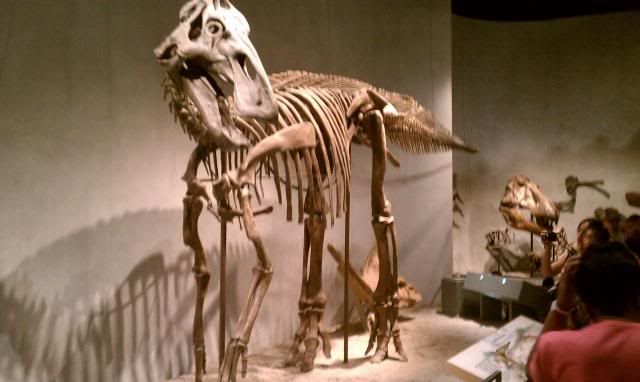Last month’s challenge was extremely easy. Thus, I did not just want the name of the critter, but why it was such an important critter as well. With in a matter of hours Inferno named the critter, and about a day later edited his post to say why it was so important.
Archaeopteryx lithographica
EDIT: Why is it important? Because Darwin predicted it. There was no link between birds and dinosaurs, then Archaeopteryx showed up. In Darwin’s lifetime.
This critter is indeed Archaeopteryx lithographica and Inferno is correct that it fulfilled a prediction Darwin made within a few years of the prediction being made.

(Taken at the New Mexico Museum of Natural History and Science)
Archaeopteryx lived during the late Jurassic, 150 to 145 million years ago in southern Germany. During that time, Europe was located close to the equator and was a large archipelago of islands in a shallow ocean. Archaeopteryx was not a very large animal, reaching 50 centimeters in length. Even though Archaeopteryx is popularly known as the first bird, it has a lot more in common with other theropods (especially the dromaeosaurs). Some of those features are a mouth full of teeth, three un-fused finger bones that included claws on each, a long bony tail, and feathers. One of the features that Archaeopteryx possesses that aligns it with birds is the atypical flight feathers found on its arms and legs. The feathers suggest that Archaeopteryx could at least glide if not outright fly. Scans of the skull of Archaeopteryx shows that it had a larger brain, including a larger vision center, than most other dinosaurs at the time, which also suggest gliding/flight capabilities.
The fossil used in last month’s challenge is known as the Berlin Specimen, and it is the most famous specimen of Archaeopteryx (and one of the most famous fossils in the world). However, the reason it is the most famous specimen is because it is the most complete, not because it was the first specimen found. The first skeletal remains of Archaeopteryx were found in 1861 and are known as the London Specimen. The London Specimen is missing a head, so the skull anatomy of Archaeopteryx was not known until the discovery of the Berlin Specimen in 1880, and its discovery further fulfilled Darwin’s prediction.
Moving on to this month’s challenge:

(Taken at the Denver Museum of Natural History and Science)
Good luck and have fun.